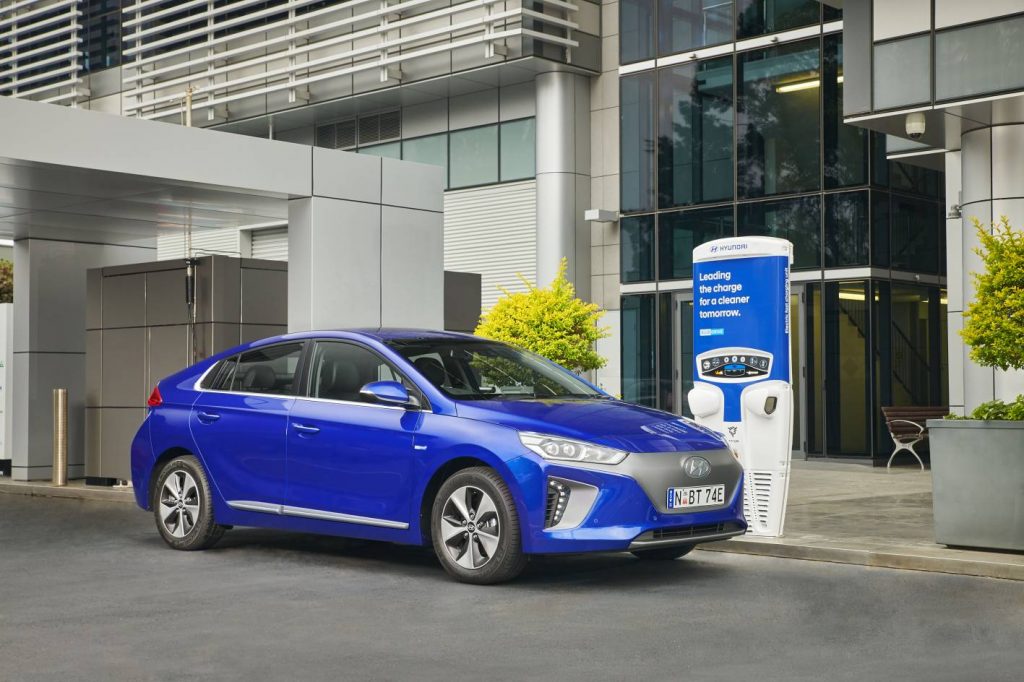FROM THE START, Hyundai always intended the Ioniq to offer three electrified powertrains – hybrid, plug-in hybrid and full electric.
It seems like only yesterday that the Ioniq arrived, but already Hyundai is adding additional technological features and a new look.
The new model gets better connectivity services (as befits a model leading the way with its drivetrains), Hyundai’s SmartSense active safety and driving assistance programs and improved infotainment features.
Outside and inside, there are some rather subtle changes, but the important news for buyers of the Ioniq all-electric model is an additional 36 percent energy capacity thanks to the larger 38.3kWh battery.

Despite Australia lagging behind in the uptake of EVs, the Ioniq has sold more than 60,000 around the world since it first appeared in 2016. Hyundai can justifiably claim to be the leader in electric powertrain choice with the hydrogen-powered Nexo, equipped with a revolutionary fuel cell electric powertrain, the Kona Electric SUV and now an enhanced range of Ioniq vehicles.
The increase in battery capacity in the Ioniq from 28 to 38.3kWh increases the range to 294km (still less than the Kona’s 400-odd km range, but a useful increase). The motor delivers maximum power of 100kW and 295Nm of torque. The on-board charger has been upgraded to 7.2kW from the previous 6.6kW for Type 2 AC charging. This means that the car can be charged to 80 percent using a 100kW fast charging station in as little as 54 minutes.

The Ioniq Hybrid and Ioniq Plug-in continue with the 1.6-litre Kappa direct injection four-cylinder engine, delivering 77kW and 147Nm.
The permanent magnet electric motor in the Hybrid delivers 32kW and maximum torque of 170Nm, using a lithium-ion polymer battery of 1.56kWh capacity.
The plug-in Ioniq’s electric motor delivers 44.5kW with maximum torque of 170Nm, using an 8.9kWh battery. Both the Plug-in and Hybrid Ioniq models deliver a system output of 103.6kW and 265Nm of torque. The Hybrid can operate in purely electric mode at speeds of up to 120km/h. The Plug-in Ioniq’s range is 52km on pure electric power.
Better connectivity.
The Ioniq is now fitted with Hyundai Blue Link which uses embedded telematics to permit remote start and stop in the Ioniq Electric, while all versions can be remotely locked or unlocked and have the air conditioning remotely controlled using a smartphone app. Owners can also remotely check the status of the battery charge and remotely control and schedule recharging using the smartphone app.
Also added to the feature list is eCall which automatically dials emergency assistance if the airbags are deployed or the call button (located above the rear-view mirror) is pressed. The program then sends relevant information to the local emergency service.
Audio video navigation is still an option and uses a 10.25-inch split, customisable touchscreen.
Android Auto and Apple CarPlay are standard across all models, but multi-Bluetooth function that allows connection of two phones simultaneously only comes if audio video navigation is specified.

Updated interior.
Newly available is a choice of four optional leather seat colours: black, grey two-tone, red umber (exclusive to Hybrid and Plug-In) and “Electric Shadow” (exclusive to the EV). The dashboard gets dark chrome accents.
The heating and climate controls have been redesigned and are more intuitive. The seven-inch LDC console display (standard on EV, optional on Hybrid and Plug-In) has been improved and now gets mood lighting appropriate to different drive modes. Blue ambient lighting operates across the passenger-side lower dashboard and centre console.
External tweaks.
The Hybrid and Plug-in models get a redesigned mesh-type radiator grille while the EV’s closed grille has been given a new pattern. Front bumpers have been updated with a silver-coloured moulding across the bottom and at the rear, there’s an anthracite rear bumper moulding. LED headlights are available for the first time and they and the daytime running lights get revised bezels. Headlights, DRLs and tail lights have all been redesigned.
Alloy wheels on the Plug-in and Hybrid are redesigned 16-inch units, while Hybrid buyers can choose between a new 15-inch or 17-inch design.
On sale second half of 2019.
Full local specifications and local pricing will be announced closer to the launch date.